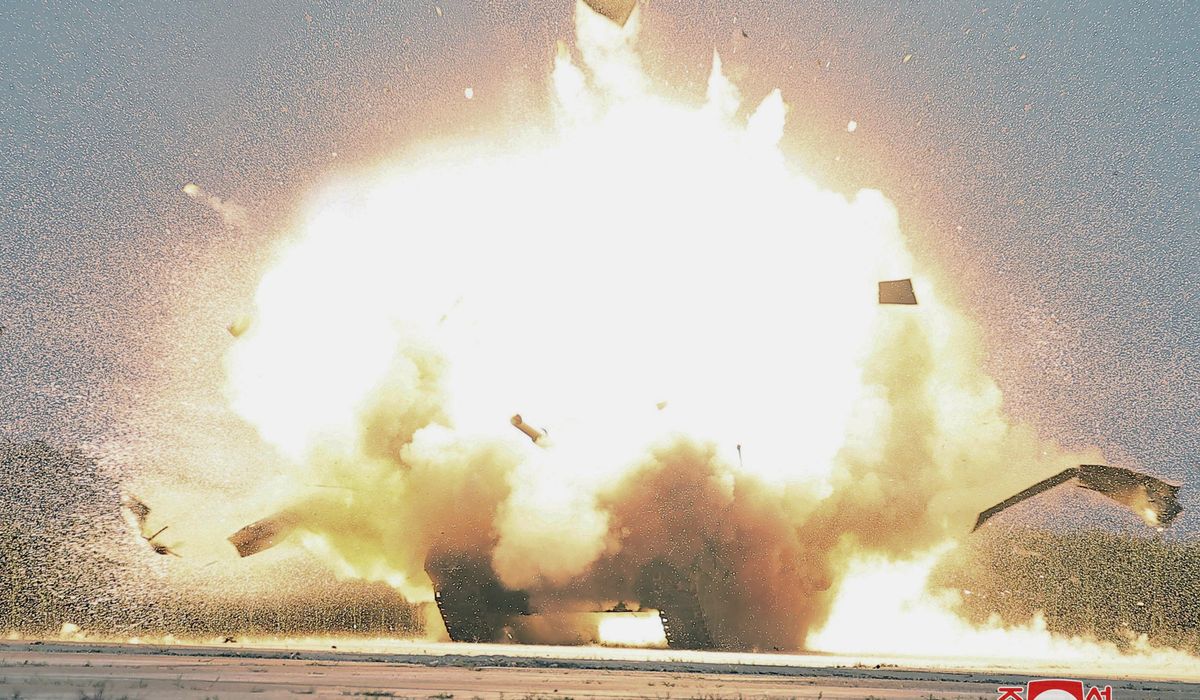


North Korean leader Kim Jong-un oversaw suicide drone tests over the weekend, an emerging vector of arms development for the fortress state, state media reported Monday.
Drones represent a near-perfect weapons solution for North Korea in its war of nerves against the South, experts say. They are an economical means of destroying expensive manned fighting platforms, have proven ability to penetrate air-defense nets and take advantage of Seoul’s innate geographical vulnerability.
Given that one of the drones shown resembles Russia’s Lancet, the new Unmanned Aerial Vehicles may be the fruits of a defense agreement the isolated state signed with Russia in June – an agreement that Seoul, Tokyo and Washington have lambasted, but have been unable to impact.
“It is necessary to develop and produce more suicide drones of various types to be used in tactical infantry and special operation units, as well as strategic reconnaissance and multi-purpose attack drones,” Mr. Kim was quoted as saying during Saturday’s tests by the state-run Korean Central News Agency.
One image showed Mr. Kim handling partially pixelated-out drones set up on display stands, while he is being briefed by military and scientific officials.
Others showed a drone in vertical strike mode destroying an armored vehicle, which some observers believe was a mock-up of a South Korean K2 tank, and a UAV deploying wings after being fired from a portable launch tube.
In a comment that may reveal North Korea’s weakness in intelligence, surveillance and reconnaissance, Kim ordered military scientists to integrate AI with drones. Autonomous robo-drones would obviate command guidance.
A game-changing weapons class
In Ukraine, drones are making the battlespace more lethal than ever for everyone from foot soldiers to distant bases.
Gruesome footage from first-person-view drones shows how cheap, civilian UAVs can be modified to drop 40mm “VOG” rifle grenades directly onto individual infantrymen in cover. Russian armored vehicles and surface warships have proven highly vulnerable to air- and sea-borne suicide drones.
Long-range Ukrainian UAVs have repeatedly penetrated Russia’s once-vaunted air-defense network, striking prestige and strategic targets — buildings in central Moscow and parked bombers in airbases hundreds of miles from the front.
Though most UAVs lack the explosive weight carried by glide bombs and missiles, Russian drone swarms have also been used in terror strikes on civilian targets.
Mr. Kim and Russian President Vladimir Putin signed a defense cooperation agreement in Pyongyang in June, but North Korea boasts native capabilities in UAVs. Drones apparently based on the U.S. Raptor and Global Hawk were visible in parades and defense exhibitions in 2023.
In December 2022, five North Korean reconnaissance drones penetrated South Korean airspace and loitered over high-value targets: The Presidential/Ministry of Defense Compound in Seoul, and Gimpo and Incheon International Airports. Efforts to shoot down the drones failed, and they returned to the North.
Kim’s perfect weapon?
South Korea’s air defense net, designed to pick up aircraft and missiles, is unsuited to detecting small, slow-moving aerial targets. That problem is exacerbated by the short distance between the inter-Korean border and the national capital.
“Seoul lacks strategic depth,” said Moon Chung-in, a North Korea expert at Seoul’s Yonsei University. It lies just 30 miles from the frontier, granting defenders minimal early warning and interception time.
As with the trash balloons that North Korea has been releasing for months, the issue of bringing down drones is problematic.
“It’s a clever tactic for North Korea,” said Yang Uk, a defense expert with the Asan Institute in Seoul. “They are operating exactly in the blank spot in our air-defense system.”
South Korean arms manufacturers produce hand-held and crew-served jamming weapons, and laser-pulse weapons have been tested against drones. A low-tech Ukrainian tactic — lines of infantry firing a barrage of automatic weapons and shotguns ahead of incoming drones — is another potential solution.
However, Seoul and its surrounding province are densely populated with 24 million people. Projectiles fired against UAVs, and falling debris from hits, could kill or wound civilians at ground zero.
“In wartime, we can use guns and cannons to build a wall of fire to intercept these things,” said Mr. Yang, referring to electric rotary cannons emplaced on the roofs of high rises and strategic heights in and around Seoul. “But right now, we can’t.”
Still, North Korea’s nascent drone likely force suffers the same weakness as its long-range missile force. Pyongyang has channeled its investments into kinetic hardware rather than the network of ISR assets required to pinpoint targets and guide weapons in-flight.
“They want to show the world that they can make the airframes themselves,” Mr. Yang said of Monday’s media reveal. “The problem for them is sensors and communications. … They need battlefield surveillance, which North Korea lacks.”
One alternative to command guidance is making UAVs entirely autonomous — and per the KCNA, Mr. Kim urged arms developers to integrate artificial intelligence.
Russia is believed to be helping North Korea with satellite programs, suggesting it could also assist with tactical intelligence, surveillance and reconnaissance.
“I don’t think North Korea can control these UAVs with satellite communications, which is what the original U.S. system does,” Mr. Yang said. “For line-of-sight communications, we may be able to jam them with electronic attacks, but with Russian help, North Korea might obtain the technologies for secure military communications.”
• Andrew Salmon can be reached at asalmon@washingtontimes.com.
